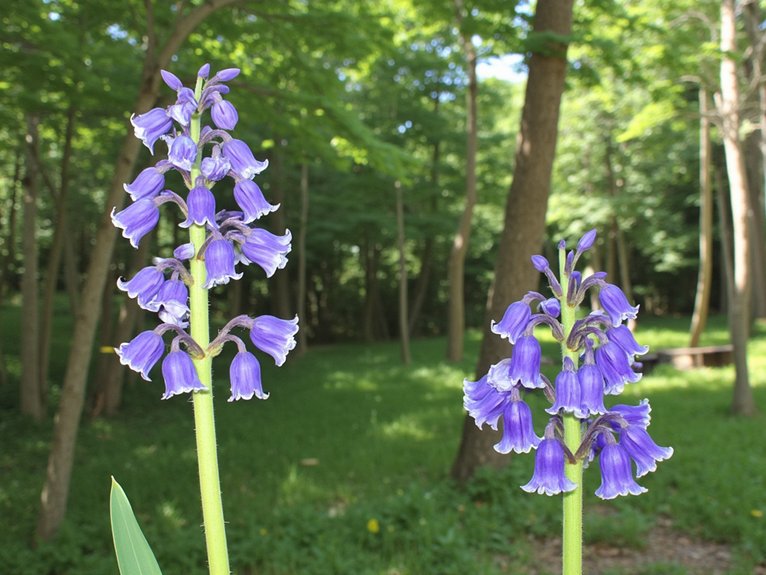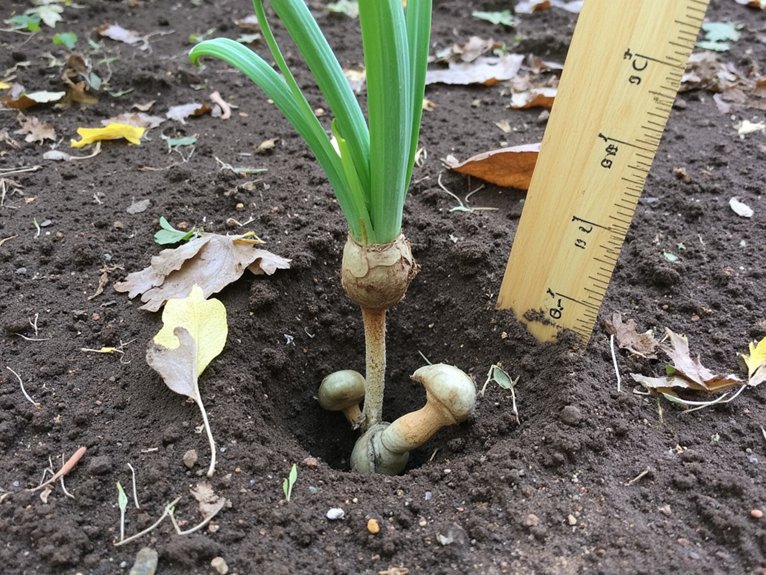Like Wordsworth’s wandering clouds of daffodils, bluebells can transform your garden into a magical spring wonderland. You’ll need to master specific techniques to achieve those dreamy carpets of nodding blue flowers. “Success with bluebells comes down to understanding their woodland heritage,” notes horticulturist Jane Morris. Whether you’re working with English or Spanish varieties, your journey to bluebell mastery starts with knowing their distinct needs and growth patterns.
Contents
Understanding English vs. Spanish Bluebells: Key Differences

When you’re deciding which bluebells to plant in your garden, it’s essential to understand the key differences between English and Spanish varieties.
English bluebells (Hyacinthoides non-scripta) display shorter stems with deep blue, drooping flowers that create a graceful arch. You’ll recognize them by their narrower leaves and intense fragrance. In contrast, Spanish bluebells stand taller with upright, lighter-colored blooms.
Be cautious about planting both varieties together, as they can cross-pollinate. This hybridization poses a risk to pure English bluebells, which are protected in their native habitats. To maintain authentic bluebell characteristics, it’s best to stick with one variety and plant them in well-defined areas.
Essential Growing Conditions for Thriving Bluebells
To give your bluebells the best chance of success, you’ll need to recreate their natural woodland habitat. Start with well-draining soil rich in organic matter, aiming for a pH between 5.5 and 7.5. If you’ve got heavy clay, mix in compost to improve drainage.
For ideal light exposure, choose a spot with dappled shade or morning sun and afternoon shade. While they’ll tolerate full sun or shade, bluebells perform best with filtered light. Plant them under deciduous trees or along the edges of woodland gardens.
Remember to maintain consistent moisture, especially for young plants. Adding a 2-inch layer of mulch will help retain water and mimic their natural forest floor environment.
Planting and Propagation Methods

Successful bluebell propagation relies on two primary methods: seed collection and bulb division. You’ll find seed collection works best in mid to late summer when pods turn brown, though plants won’t flower for 2-5 years.
For quicker results, opt for bulb division in late summer after foliage dies back. Here’s how:
- Carefully dig around mature clumps
- Separate bulbs gently by hand
- Replant immediately 4-5 inches deep
- Space bulbs 3-4 inches apart
- Water thoroughly
Year-Round Care and Maintenance Tips
Proper year-round maintenance guarantees your bluebells will thrive season after season. Focus on seasonal care by leaving foliage intact until it naturally dies back, allowing nutrients to return to the bulbs. During spring flowering, water consistently but don’t overwater.
For effective pest management, monitor for slugs and snails, especially in damp conditions. Apply organic slug deterrents if needed. You’ll only need fertilizer in poor soils – a balanced flower feed high in phosphorus works best.
After blooms fade, deadhead spent flowers unless you’re collecting seeds. Remove fallen leaves in late summer and apply a fresh layer of mulch to protect bulbs over winter.
Container Growing and Garden Design With Bluebells

Designing with bluebells lets you create enchanting container gardens and woodland-inspired landscapes that burst with spring color. When designing containers, plant bulbs closely together, about 2-3 inches apart, in well-draining potting mix. Choose deep pots with drainage holes and position the bulbs’ roots downward.
For companion planting, pair bluebells with early-spring flowering bulbs like daffodils or woodland perennials such as ferns and hostas. In garden beds, plant them in drifts of 10-15 bulbs to mimic natural woodland settings. They’ll thrive under deciduous trees where they’ll receive dappled sunlight and create stunning carpets of blue.
